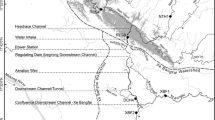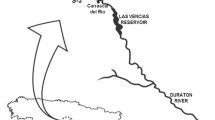Abstract
Water entering Lake Magadi from a spring contained 73 mg fluoride (F)1-1, while samples taken 100 and 400 m from the spring were estimated to contain 110 and 140 mg F 1-1. Evaporation apparently increased the F and salt concentrations to levels at which the common method of F analyses became unreliable, even after dilution. It is recommended to re-examine the very high F levels reported in the saline lakes of Rift Valley. The F levels of Tilapia grahami living in water with about 110 mg F 1-1 averaged (mg F kg-1 dry weight): fillet 68, skin 819, gills 1,366 and bones 1,661. The variation was highest in fillet and skin. There was no positive correlation between tissue F levels and fish size (range 3–20 g). It remains uncertain whether the fish bone was saturated at this concentration of F or if some mechanism of elimination hindered higher F accumulation in the skeletal structures.
Similar content being viewed by others
References
Bell, M. E., E. J. Largent, T. G. Ludwig, J. C. Muhler & G. K. Stookey, 1970. The supply of fluorine to man. In Fluorides and Human Health. World Health Organization, Geneva: 17–74.
Berg, H. & J. Haug, 1970. The fluoride content and food value of Kenya lake fish. E. Aft. Agr. Forest. J. 36: 392–400.
Birkeland, J. M., 1970. Direct potentiometric determination of fluoride in soft tooth deposits. Caries Res. 4: 243–255.
Christensen, B., 1987. Uptake and release of fluoride in arctic char. Envir. Toxicol. Chem. 6: 529–533.
Kariuki, D. N., H. M. Thairu & L. W. Njenga, 1984. Dietary sources of fluoride in Kenya. In S. Likimani (ed.), Fluorosis Research Strategies. Aft. Med. Res. Found., Nairobi: 32–36.
Manji, F. & S. Kapila, 1984. Fluorides and fluorosis in Kenya — an overview. In S. Likimani (ed.), Fluorosis Research Strategies. Aft. Med. Res. Found., Nairobi: 11–21.
Neuhold, J. M. & W. F. Sigler, 1962. Chlorides affect the toxicity of fluorides to rainbow trout. Science 135: 732–733.
Opinya, G. N., N. Bwibo, J. Valderhaug, J. M. Birkeland & P. Lökken, 1991. Intake of fluoride and excretion in mothers' milk in a high fluoride (9 ppm) area in Kenya. Eur. J. Clin. Nutr. 45: 37–41.
Reite, O. B., G. M. O. Maloiy & B. Aasehaug, 1974. pH, salinity and temperature tolerance of Lake Magadi Tilapia. Nature 247: 315.
Sigler, W. F. & J. M. Neuhold, 1972. Fluoride intoxication in fish: A review. J. Wildlife Dis. 8: 252–254.
Williamson, M. M., 1953. Endemic dental fluorosis in Kenya: a preliminary report. E. Aft. Med. J. 30: 217–233.
Wright, D. A. & A. W. Davison, 1975. The accumulation of fluorides by marine and intertidal animals. Envir. Pollut. 8: 1–13.
Author information
Authors and Affiliations
Additional information
author for correspondence
author for correspondence
Rights and permissions
About this article
Cite this article
Gikunju, J.K., Maitho, T.E., Birkeland, J.M. et al. Fluoride levels in water and fish from Lake Magadi (Kenya). Hydrobiologia 234, 123–127 (1992). https://doi.org/10.1007/BF00010867
Received:
Revised:
Accepted:
Issue Date:
DOI: https://doi.org/10.1007/BF00010867




